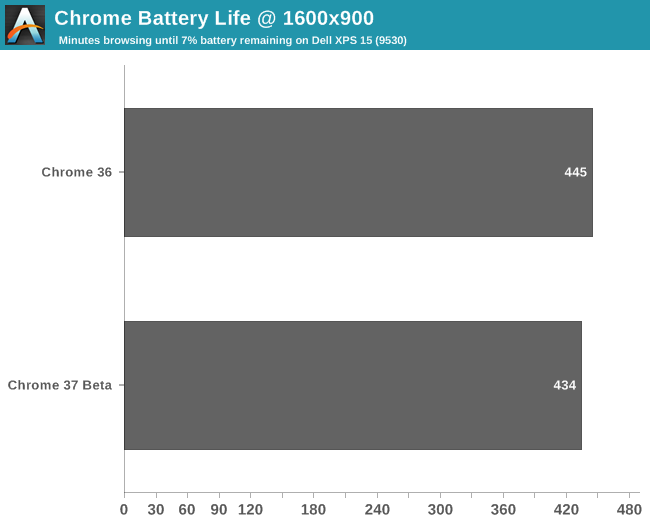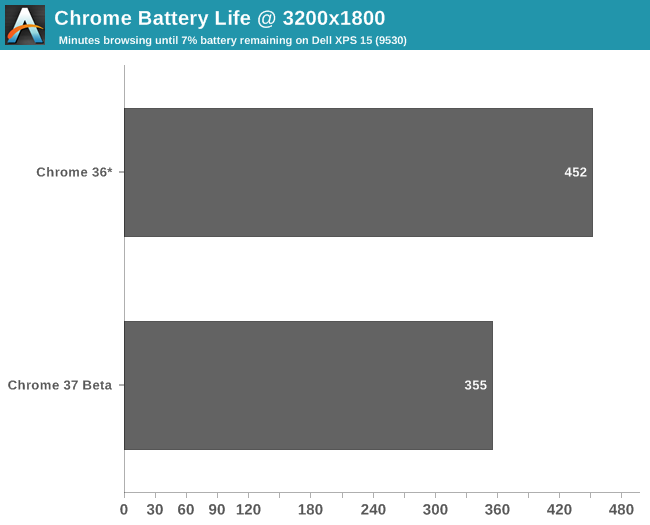Browser Face-Off: Chrome 37 Beta Battery Life Revisited
by Stephen Barrett on August 18, 2014 6:00 AM EST
Last week we posted our Browser Face-Off: Battery Life Explored 2014, where the battery run down times of Firefox 31, IE11 Desktop, IE11 Modern, Chrome 36, and Chrome 37 beta were tested on Windows. We used GUI automation to open browsers, tabs, and visit websites to simulate a real user in a light reading pattern. The article answered a lot of questions about popular browser battery life on Windows, but it raised additional questions as well.
Chrome 36 tested with the best battery life, but was the only browser that did not render correctly at 3200x1800 due to lack of HiDPI support. In the Chrome 37 beta, HiDPI support improved rendering but also took a 25% dive in battery life tying it for last place. However, the Chrome 37 beta includes more changes than just HiDPI support (along with some debugging code), so was the battery life penalty from the now-native 3200x1800 rendering or was it something else? After a few more days of testing at 1600x900 with 100% DPI scaling, we can narrow in on an answer.

When both Chrome 36 and Chrome 37 beta natively render at 1600x900 there is less than 3% difference in battery life. Two tests of each browser were performed and the results averaged. The variation between runs was only 1%. Looking at our previous numbers of Chome 36 and 37 beta on the HiDPI setting of 3200x1800 and 200% scaling, the situation is entirely different.

I've added an asterisk here (and clarified the same text on the original article) to indicate Chrome 36 isn't actually rendering at 3200x1800, but rather at 1600x900 and relying on Windows DPI Virtualization to scale up to 3200x1800.
Looking at the numbers, there's some good news and some bad news. The good news is that Chrome 37's new features likely won't hurt the battery life of current users. If you are using Chrome now, you are probably not using a HiDPI display due to the existing blurry rendering. For these users, the pending Chrome 37 upgrade has no significant impact on battery life. The bad news is that if you have been avoiding Chrome due to its HiDPI rending issues, Chrome 37 resolves those issues but also appears to provide worse battery efficiency compared to Internet Explorer. On our XPS 15 that equated to about an hour less of mobility.
Given that this is the first version of Chrome to properly support HiDPI, it's entirely possible – even likely – that there are many opportunities to further optimize the algorithms and hopefully return battery life at least close to Chome 36 levels. A slight dip in battery life is expected as it takes more work to render a 3200x1800 image compared to a 1600x900 image, but a 20% drop seems rather extreme. We'll have to see what future updates bring, but hopefully by noting the discrepancy it will encourage developers to better tune performance.










22 Comments
View All Comments
Stephen Barrett - Monday, August 18, 2014 - link
To be fair, the original article stated that the Chrome 36 results at 3200x1800 were suspect due to lack of HiDPI support. In both the results page and on the final words page.However, I have updated the original article to link to this.
eddman - Tuesday, August 19, 2014 - link
Now that I think about it, why don't you rerun the test for all browsers at a lower, common resolution, say 1920 x 1080?Let's see how they do then.
Heavensrevenge - Monday, August 18, 2014 - link
BTW I found the way to make Chrome request the normal resolution timer vs the High Res timer (accidentally discovered it doing unit test during a power outage) lol. Set the active power plan to "Power Saver" and chrome's perf with degrade ~3x just as you were hoping for :P So you may need to re-test all the browsers under that power plan too in order to get the real "battery life".Stephen Barrett - Monday, August 18, 2014 - link
All AnandTech benchmarks run in "Power Saver" mode. Slightly customized from the default though.mkozakewich - Monday, August 18, 2014 - link
Wait, wouldn't that mean that you weren't even testing what you set out to test? If Chrome uses the regular timers on Power Saver, and you wanted to test how the fast clock affects battery life, you haven't actually tested it.Stephen Barrett - Monday, August 18, 2014 - link
Chrome does not use regular timers on battery saver mode (or ever). See page 3 of the original article. I verified that it was indeed requesting the high priority timer as the test was running.Also, see the second to last paragraph of the first page. It talks about this specifically.
Heavensrevenge - Tuesday, August 19, 2014 - link
Then explain this: I set my power plan to "Power Savings and start Chrome (Stable as you can tell by the version # in the report) AFTER setting to the power savings power plan and here:http://i.imgur.com/HlMxr3L.png to see chrome NOT requesting the higher timer WHILE running the sunspider javascript benchmark twice during the recording period
AND
https://mega.co.nz/#!thBUCKCT!RxVWNSEbw0b_-tCJCdrc... is the entire energy report that shows all the details of more chrome.exe processes vs just that single screen shot with 1 entry + the timer resolution to show u chrome doesn't ONLY request the high resolution timer no-matter what.
BTW the Dev version of Opera based on chrome ALSO doesn't force a high resolution timer but Firefox Nightly AND Chrome Canary seems to always request the high resolution timer for me so eat your own hat anand & staff.
josby - Monday, August 18, 2014 - link
Given the pace of software updates, this test strikes me as a little premature. Yes, HiDPI displays are the future, but so are Chrome 41, IE 13, etc. Right now, I'd imagine the vast majority of AnandTech readers are still on traditional displays. Tests of the software/hardware combos most of use are using now would be more useful than tests of software that will be long-outdated by the time most of us are on HiDPI displays.Gigaplex - Monday, August 18, 2014 - link
Why does a 20% drop in battery life seem extreme when rendering 4 times the number of pixels?DanNeely - Monday, August 18, 2014 - link
Because it went from slightly better than IE or Firefox to far worse than either of them.